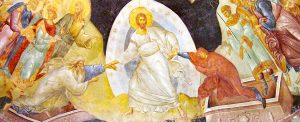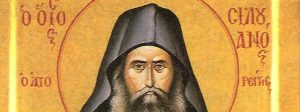Introduction
by translator Cyril Richardson
The significance of these seven letters lies in their being intimate, familiar, and popular. They do not, in the first instance, reveal a set of ideas, though they are not lacking in thoughtfulness. Rather do they reveal a man. So much of early Christian literature is impersonal that it is refreshing to stumble upon letters reminiscent of the frank and personal note of Paul’s correspondence.
The conditions under which Ignatius’ letters were written did not make for careful reflection. They are the letters of a prisoner on his way to martyrdom. Their religious character is popular rather than deep. Their style is compressed and turbulent, reflecting the brusque and impetuous nature of their author (To the Trallians, ch. 4), as well as the irritation of a captive subjected to brutality (To the Romans 5:1). Their metaphors change with alarming abruptness, and are often more striking than apt (Ephesians, ch. 9). Their grammar is not free from carelessness. Yet for these very reasons they have a peculiar value. They disclose a real person, expressing himself in the moment of crisis, and so making clear the ruling passions of his life.
Our knowledge of Ignatius is confined almost entirely to these letters. It is only for the few days when he journeys from Philadelphia to Troas under a military guard that we catch a glimpse of this early second century bishop.
Ignatius was bishop of Antioch in Syria, and during a short but intense persecution of that city had been condemned to fight with wild beasts in Rome. Perhaps others had suffered the same fate, but this is not altogether clear unless we so interpret the reference in his letter to the Romans, ch. 10. In any case, chained to a squad of soldiers, he is taken by the overland route through Cilicia and Asia Minor, and thence to Rome. Where the way forks at Laodicea, the northern road is chosen. He halts at Philadelphia, and then again at Smyrna, where he is welcomed by Polycarp, the bishop of that city, and by delegates from the neighboring churches of Ephesus, Magnesia, and Tralles. It is from Smyrna too that he writes the first four of his letters—three to the churches that had sent delegates and one to the church at Rome. Pressing northward, he stops again at Troas. From here he corresponds with the churches of Philadelphia and Smyrna, and adds a personal note to Polycarp. We gather that he crossed by sea to Neapolis and halted once more at Philippi, where the Christians welcomed him. After that he passes out of sight. We may, however, assume that he reached Italy by way of Dyrrhacium and Brundisium. Furthermore, tradition relates that he was eventually martyred in the Coliseum sometime during Trajan’s reign (A.D. 98–117).
Ignatius’ letters are dominated by three concerns. First is his approaching martyrdom. To “imitate the Passion of my God” (Rom. 6:3) is the exclusive theme of the letter to the Romans, but it underlies the others as well. This, for him, is the way to become a “real disciple,” a “genuine Christian.” He is clearly impatient to “get to God” by way of martyrdom; and to brace himself for the ordeal he pictures in startling detail what this must mean for him (Rom. 5:2, 3). We are not, therefore, surprised that the same line of thought is reflected in other aspects of the letters. His theology, for instance, revolves around the blood of Christ (cf. the striking and compressed thought of Eph. 1:1); and he emphasizes the reality of Christ’s Passion by pointing to his own imminent death (Smyr. 4:2).
The second concern is for the unity of the Church. Against threatening schisms, Ignatius is persistent in his stress on obedience to the Church authorities. In his letters there first emerges the picture of the local congregation governed by a single bishop who is supported by a council of presbyters and assisted by deacons. In this Ignatius betrays a stage of development beyond the situation reflected in the Pastoral Epistles, the Didache, and I Clement. There the titles “bishop” and “presbyter,” and perhaps the offices too, are not as clearly distinguished. There, the local congregations are ruled by boards of officials (sometimes called bishops, sometimes presbyters), subject only to apostolic figures, such as Timothy and Titus, or to itinerant prophets. In Ignatius, on the contrary, the single bishop is the leading figure in the Church. Without his approval no services are to be held (Smyr. 8:2) or other action taken (Trall. 7:2). He seems to represent the localizing of the teaching, ruling, and prophetic functions of the original missionary ministry of apostles, prophets, and catechists. This process had, indeed, already started in the Didache (see ch. 13); but in Ignatius it is complete.
What, however, is most striking about this appearance of the monepiscopate in Ignatius is the lack of an explicit doctrine of apostolical succession. For him the authority of the Church officers is not derived from a chain of teaching chairs (as in Irenaeus) or from a succession of ordinations (as in Augustine), but from the fact that their offices are the earthly antitype of a heavenly pattern. The bishop, for instance, represents God; the presbyters, the apostles; and the deacons, Christ (Mag. 6:1). Such teaching stands in marked contrast with those views of authority that emphasize the historical connection between the episcopate and the apostles. Rather is it a mystical nexus between the earthly Church and the sphere of the divine, which is fundamental in Ignatius. It is this that makes it possible for him to urge that deference to the bishop is the same thing as deference to God (Eph. 5:3–6).
The bishop in Ignatius, moreover, is not only an administrative and liturgical officer. He is also a prophet. This is especially true in his own case. In Philad., ch. 7, he gives us an instance of his gifts in this direction, while the name Theophorus (“God-bearer”), which he assumes, is likely not a proper name but an epithet to indicate his prophetic character. One may note, similarly, how he urges Polycarp to seek for heavenly revelations (Poly. 2:2). Not inappropriately, therefore, did the Smyrnaeans remember Polycarp as “an apostolic and prophetic teacher” (Mart. Poly. 16:2).
The third concern in Ignatius is to unmask those heretical movements which are leading to schism. Two of these are prevalent; and while he does not go into detail, believing as he does more in order than in argument, we may gather their main features from his casual references.
In Philadelphia he came into personal contact with a Judaizing movement similar to the one attacked by Paul in his Letter to the Galatians and mentioned later in the book of Revelation (ch. 3:9). It was, to be sure, not so thoroughgoing as that faced by Paul, circumcision not being demanded of its Gentile devotees (Philad. 6:1). But the observance of the Jewish Sabbath was involved, along with belief in certain Jewish traditions and allegories (Mag., chs. 8; 9).
At the opposite pole to this error was the Docetic heresy, rife in Smyrna. Here the attempt to accommodate the gospel to Greek culture had gone to the limit of denying the reality of the Lord’s body. The basic Hellenistic idea that matter was evil led inevitably to disbelief in the incarnation. God could not have a direct relation with the sensible world, since this was the province of evil; accordingly, Christ could not have been genuinely man. He only appeared or seemed to have a body (whence “Docetism,” from the Greek dokeō, seem), being as it were a phantom from the heavenly sphere. The way Ignatius plays on this theme is interesting. By inventing a sham Christ (a Christ who only “seems” to be), the Docetics prove themselves to be a sham, and they will end up by becoming apparitions! (Trall., ch. 10; Smyr., ch. 2).
Against such views Ignatius introduces two of the leading emphases of his theology. One is the divinity of Christ. This was compromised by the Judaizing movement, which viewed him as the last of the prophets. For Ignatius, Christ is “our God.” He can even speak of the “Christ God” (Smyr. 10:1), revealing by such an expression his own Christocentric faith and also something of the liberal use of the word theos (god) to be found in Hellenistic circles.
The other emphasis of Ignatius’ Christianity falls upon the reality of the incarnation, Passion, and resurrection of the Christ. He continually stresses the genuine and actual nature of these occurrences and the inseparable unity of flesh and spirit—even after the resurrection (Smyr., ch. 3). So much so, that such repeated phrases as “in flesh and in spirit” become expressions similar to our “body and soul,” and are used as synonyms for “thoroughly” or “completely” (cf. Eph. 10:3; Mag. 13:2).
While these are two of the central themes of Ignatius’ thought, recent study has drawn attention to other aspects of it. One concerns the affinities between Ignatius and the Gnostics. There are, indeed, traces of Gnostic terminology in the letters; but Ignatius was not a Gnostic: he was very far from it. His was not a speculative mind. Indeed, it is the simplicity and uncompromising quality of his basic convictions, so frequently expressed in compact, credal statements, which are most characteristic of him. That is not, however, to deny that Ignatius is comfortable using phrases and ideas familiar from Hellenistic religion and previously uncommon in the general stream of Biblical thought. The Eucharist is “the medicine of immortality” (Eph. 20:2); Christians are “full of God” (Mag., ch. 14); God is Sigē (silence, Mag. 8:2); and the divine sphere is Plērōma (fullness, Eph., inscr.). Again, Ignatius alludes to the idea of the New Man (Eph. 20:1), and in his Church mysticism the earthly order reflects the heavenly pattern. Yet the central convictions of the Christian faith are always clearly—even dogmatically—affirmed, while against the basic Gnostic tenet that matter is evil, he wages a constant warfare.
Closely connected with this issue are others which bear upon Ignatius’ relation to the New Testament faith. Does he deviate from the Pauline gospel? Is he influenced by John? Does he depart from John? It is not needful here to review these complex questions at length. Rather should the reader bear them in mind as he surveys the letters. One or two points, however, may be noted.
Ignatius knew several letters of Paul —perhaps the original corpus of seven. He was most familiar with I Corinthians. He probably knew Ephesians; and there may be reminiscences of others. Some parts of the Pauline gospel—above all, the sense of fellowship with the crucified and risen Christ—he understood well, though sometimes he uses Pauline phrases with meanings that widely differ from the original (e.g., Rom. 5:1; Eph. 8:2).
With regard to John, there are a number of possible reminiscences (Mag. 7:1; Rom. 7:2, 3; Philad. 7:1; 9:1), and there is a close relation between the views of John and Ignatius on the Eucharist (cf. John 6:54 with Eph. 20:2, and Smyr. 7:1).
“A soul seething with the divine eros“—such is Chrysostom’s description of Ignatius in his eulogy delivered on the martyr’s feast in Antioch. It is an apt phrase, for more reasons than Chrysostom intended. There is a religious vehemence about these letters, even an impatience and a heat of excitement, which is fittingly expressed by the classical eros. Ignatius is himself aware of his lack of gentleness and calm (Trall. 4:2). He had, too, something of those sharp alternations of pride and humility, which we meet in Paul (Trall., chs. 4; 5). His letter to the Romans, moreover, expresses that exaggerated passion for martyrdom which the Church later sought to restrain. In the light of these traits it is interesting to notice how struck Ignatius was by the bishops of Ephesus and Philadelphia (Eph., ch. 6; Philad. 1:1). He saw in their modest and retiring character what was most lacking in his own. By their quietness they seemed the more effectual and, as bishops, were the better able to mirror the divine nature which their office represented (Eph., chs. 6; 15). God’s essential character was that of silence—a silence broken only at the incarnation, and even then with reserve and modesty (Eph., ch. 19).
Yet, for all this, there is a nobility about this Oriental martyr. He can recognize his weakness, and he has grasped the central truth of the Christian gospel, incorporating it into his very life. He will suffer with Christ and so become a genuine disciple.
Manuscripts and Books
The letters of Ignatius were first collected by Polycarp, the bishop of Smyrna, who sent copies of them to the church at Philippi not long after Ignatius had left that city on his way across Macedonia (Phil., ch. 13). Whether this collection contained all seven letters is not clear. Possibly Polycarp did not have access to the one to the Romans, though this was early in circulation, being quoted by Irenaeus (Adv. haer. V. 28:4), and known, of course, to Eusebius. It is likely that copies of all the letters were kept by Ignatius’ amanuensis, the Ephesian Burrhus (see Philad. 11:2), and that Polycarp obtained them from him.
We possess no manuscript of the original corpus, for in the fourth century the letters were interpolated and six additional ones added (Mary of Cassobola to Ignatius; Ignatius to Mary, to the Tarsians, Philippians, Antiochenes, and to Hero, deacon of Antioch). The aim of these forgeries was to gain for a diluted form of Arianism the authority of a primitive martyr. Finally, in the Middle Ages, a correspondence between Ignatius and the Virgin Mary, as well as two letters of Ignatius to John the Apostle, was fabricated in the West.
With the revival of learning in the Renaissance a critical spirit toward the Ignatian corpus first arose; but it was not until the labors of Theodor Zahn and J. B. Lightfoot in the nineteenth century that the question was finally settled and the genuine form of the letters of Ignatius was fully established.
A pioneer work which attempted to separate the wheat from the chaff was that of the Genevan professor Nicholaus Vedelius in 1623. He printed the seven letters known to Eusebius by themselves, relegating the six spurious ones to a separate volume.
The controversy with the Puritans over episcopacy brought the question of the genuineness of Ignatius’ correspondence into the foreground; and, in his efforts to defend this, Ussher came upon two Latin manuscripts that contained versions of the text corresponding to that known to Eusebius and other fathers in the fourth century.
The authenticity of the text defended by Ussher and Voss was soon attacked by French Calvinists (notably by Jean Daillé in Geneva, 1666); but a full and learned reply was offered by Bishop John Pearson in his Vindiciae Ignatianae, 1672.
To summarize: the letters of Ignatius have come down to us in three forms. There is the long recension, interpolated in the fourth century. There is the short Syriac recension, which is an abridgment of the authentic letters. Finally there is the middle recension, or genuine text.
A full description of the manuscripts (including the Armenian, and the Syriac and Coptic fragments) will be found in Lightfoot, op. cit., pp. 70–126; 587–598. To this must be added the fifth century Berlin papyrus fragment of Smyrnaeans (in Greek: see C. Schmidt and W. Schubert in Altchristliche Texte, Berliner Klassikertexte, Heft VI, 1910), and the Coptic fragments published by Carl Wessely in Sitzungsberichte der kais. Akademie der Wissenschaften in Wien, Vol. CLXXII, Part 4, 1913.
From Early Christian Fathers, translated by Cyril Richardson






